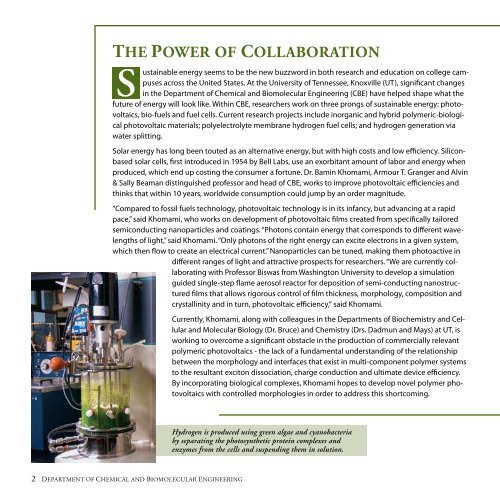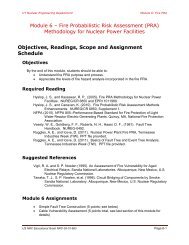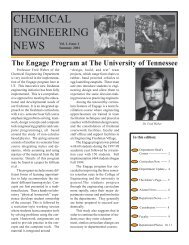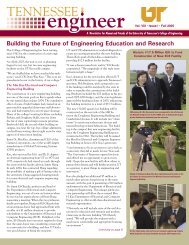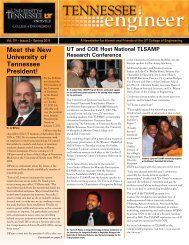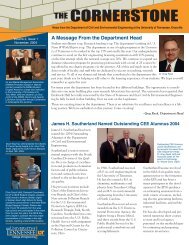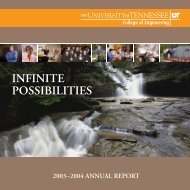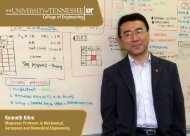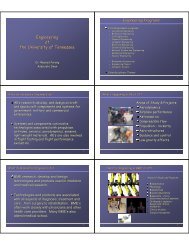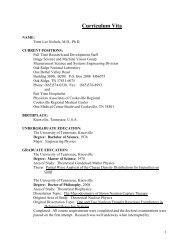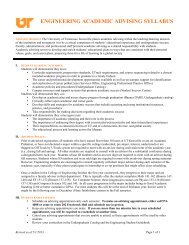CBE 2007 Annual Report - College of Engineering - The University ...
CBE 2007 Annual Report - College of Engineering - The University ...
CBE 2007 Annual Report - College of Engineering - The University ...
You also want an ePaper? Increase the reach of your titles
YUMPU automatically turns print PDFs into web optimized ePapers that Google loves.
THE POWER OF COLLABORATION<br />
S<br />
ustainable energy seems to be the new buzzword in both research and education on college campuses<br />
across the United States. At the <strong>University</strong> <strong>of</strong> Tennessee, Knoxville (UT), significant changes<br />
in the Department <strong>of</strong> Chemical and Biomolecular <strong>Engineering</strong> (<strong>CBE</strong>) have helped shape what the<br />
future <strong>of</strong> energy will look like. Within <strong>CBE</strong>, researchers work on three prongs <strong>of</strong> sustainable energy: photovoltaics,<br />
bio-fuels and fuel cells. Current research projects include inorganic and hybrid polymeric-biological<br />
photovoltaic materials; polyelectrolyte membrane hydrogen fuel cells; and hydrogen generation via<br />
water splitting.<br />
Solar energy has long been touted as an alternative energy, but with high costs and low efficiency. Siliconbased<br />
solar cells, first introduced in 1954 by Bell Labs, use an exorbitant amount <strong>of</strong> labor and energy when<br />
produced, which end up costing the consumer a fortune. Dr. Bamin Khomami, Armour T. Granger and Alvin<br />
& Sally Beaman distinguished pr<strong>of</strong>essor and head <strong>of</strong> <strong>CBE</strong>, works to improve photovoltaic efficiencies and<br />
thinks that within 10 years, worldwide consumption could jump by an order magnitude.<br />
“Compared to fossil fuels technology, photovoltaic technology is in its infancy, but advancing at a rapid<br />
pace,” said Khomami, who works on development <strong>of</strong> photovoltaic films created from specifically tailored<br />
semiconducting nanoparticles and coatings. “Photons contain energy that corresponds to different wavelengths<br />
<strong>of</strong> light,” said Khomami. “Only photons <strong>of</strong> the right energy can excite electrons in a given system,<br />
which then flow to create an electrical current.” Nanoparticles can be tuned, making them photoactive in<br />
different ranges <strong>of</strong> light and attractive prospects for researchers. “We are currently collaborating<br />
with Pr<strong>of</strong>essor Biswas from Washington <strong>University</strong> to develop a simulation<br />
guided single-step flame aerosol reactor for deposition <strong>of</strong> semi-conducting nanostructured<br />
films that allows rigorous control <strong>of</strong> film thickness, morphology, composition and<br />
crystallinity and in turn, photovoltaic efficiency,“ said Khomami.<br />
2 DEPARTMENT OF CHEMICAL AND BIOMOLECULAR ENGINEERING<br />
Currently, Khomami, along with colleagues in the Departments <strong>of</strong> Biochemistry and Cellular<br />
and Molecular Biology (Dr. Bruce) and Chemistry (Drs. Dadmun and Mays) at UT, is<br />
working to overcome a significant obstacle in the production <strong>of</strong> commercially relevant<br />
polymeric photovoltaics - the lack <strong>of</strong> a fundamental understanding <strong>of</strong> the relationship<br />
between the morphology and interfaces that exist in multi-component polymer systems<br />
to the resultant exciton dissociation, charge conduction and ultimate device efficiency.<br />
By incorporating biological complexes, Khomami hopes to develop novel polymer photovoltaics<br />
with controlled morphologies in order to address this shortcoming.<br />
Hydrogen is produced using green algae and cyanobacteria<br />
by separating the photosynthetic protein complexes and<br />
enzymes from the cells and suspending them in solution.<br />
“Incorporation <strong>of</strong> the biological complex at the biphasic interface<br />
will provide a dramatic improvement in the exciton<br />
dissociation process and thus provide a clear mechanism<br />
to improve device efficiency,” said Khomami. “<strong>The</strong> use <strong>of</strong><br />
diblock copolymers provides a robust method to control the<br />
morphology <strong>of</strong> the result photovoltaic material.” Researchers<br />
are faced with surmountable challenges in this process,<br />
including developing conducting polymers that microphase<br />
separately into traditional diblock morphologies and developing<br />
strategies to guide biological complexes to the biphasic<br />
interface to realize their potential <strong>of</strong> optimizing exciton<br />
dissociation. “<strong>The</strong> project plan is designed to address these<br />
hurdles while creating a material that optimizes the device<br />
efficiency by controlling the morphology and interfaces and<br />
simultaneously providing fundamental information to enable<br />
the reproducible and efficient production <strong>of</strong> the next<br />
generation <strong>of</strong> photovoltaic materials created from multicomponent<br />
conjugated polymer systems,” said Khomami.<br />
Dr. Brian Edwards, associate pr<strong>of</strong>essor and associate head <strong>of</strong><br />
<strong>CBE</strong>, and Drs. David Keffer and Stephen Paddison, associate<br />
pr<strong>of</strong>essors in <strong>CBE</strong>, also play a significant role in the sustainable<br />
energy arena through their work on proton transport in<br />
proton exchange membrane (PEM) fuel cells.<br />
“<strong>The</strong> idea is that it doesn’t matter if you’re generating energy<br />
for a power plant, home or car, all these processes create CO2<br />
and contribute to the main cause <strong>of</strong> global warming,” said<br />
Keffer. “We need to find alternative ways <strong>of</strong> generating power<br />
and relevant to this theme <strong>of</strong> sustainable energy research in<br />
the university is the work we’re doing with fuel cells.”<br />
In a fuel cell, hydrogen enters and is split into protons and<br />
electrons by a platinum catalyst. Electrons are carried <strong>of</strong>f to<br />
do electrical work, and the protons have to complete the<br />
circuit by being transported through a membrane separat-<br />
ing the electrodes. But for over 40 years, researchers have<br />
been stumped as to how the protons move through the<br />
electrode-electrolyte interface. Keffer, Edwards and Paddison<br />
are performing multiscale simulations to elucidate the<br />
mechanism <strong>of</strong> proton transport and nanostructure formation<br />
in PEM fuel cells.<br />
“We’re going to have to start thinking differently about how<br />
we make energy because we can’t make it like we are now,”<br />
said Dr. Paul Frymier, associate pr<strong>of</strong>essor in <strong>CBE</strong> whose forward-thinking<br />
idea <strong>of</strong> energy production is to use plants for<br />
energy.<br />
For billions <strong>of</strong> years, plants have transformed sunlight into<br />
energy through photosynthesis. Frymier and Dr. Barry Bruce,<br />
pr<strong>of</strong>essor <strong>of</strong> biochemistry and cellular and molecular biology<br />
and adjunct pr<strong>of</strong>essor in <strong>CBE</strong> at UT, believe this natural<br />
process can be used to create energy efficiently. “I’ve always<br />
been curious about a way to produce energy sustainably,”<br />
said Frymier whose research focus is on in vitro (cell-free)<br />
systems for producing hydrogen because lots <strong>of</strong> energy is invested<br />
in sustaining enough live algae to produce hydrogen.<br />
Frymier also concentrates on engineering and optimization<br />
<strong>of</strong> photosynthetic routes to biohydrogen.<br />
Whether processing spinach, PV films or proton exchange<br />
membranes, <strong>CBE</strong> researchers are contributing to the future <strong>of</strong><br />
sustainable research and development in the energy sector.<br />
“<strong>The</strong>re’s more to sustainability than energy,” said Bruce. “It’s<br />
never been part <strong>of</strong> the equation, but we have to change the<br />
energy dimension <strong>of</strong> the production process. We’re trying to<br />
create a paradigm shift in how engineers are trained. <strong>The</strong>y<br />
have not put sustainability in their equations, and I believe<br />
the new paradigm <strong>of</strong> engineering will have to address more<br />
complex parameters than the typical engineer usually does.”<br />
<strong>2007</strong> ANNUAL REPORT 3


